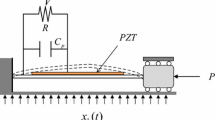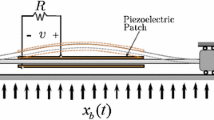Abstract
The rotational vibration energy harvester is designed to convert the mechanical energy in the environment to useful electric energy. The vibration source in the nature is always broadband and implied randomness. To exploit the random dynamical characteristic of the rotational energy harvester, the steady-state response of a two-degree-of-freedom system under random excitation is investigated. The rotational component seems as an inerter, which induces an additional degree-of-freedom. Firstly, the linear system is analyzed, and the influence of the system parameters on the stationary mean-square response is discussed. The lower natural frequency of the primary system and higher natural frequency of the generator are good for improving the harvester’s performance. Then, the nonlinear stiffness is considered to show the nonlinear behavior of the energy harvester under random excitation. The stochastic averaging of quasi-non-integrable Hamilton system is applied to solve the steady-state probabilistic density function. The results show that the nonlinear stiffness plays a negligible role to the harvester. The comparison between the analytical and Monte-Carlo simulation results validates the accuracy of the proposed technique within a certain parameter range. When the parameters tend to a small value (i.e., \({\omega }_{2}\to 1\)), the analytical results will deviate those from Monte-Carlo simulation, which is mainly due to the degeneration of the non-integrability of Hamilton system. Finally, in order to analyzing the situation of \({\omega }_{2}\to 1\), the equivalent linearization technique is adopted to evaluate the mean-square response and the output power. The accuracy of the results is good. For small frequency \({\omega }_{2}\), the output power is small.













Similar content being viewed by others
References
Wei, C., Jing, X.: A comprehensive review on vibration energy harvesting: modelling and realization. Renew. Sustain. Energy Rev. 74, 1–18 (2017)
Harne, R.L., Wang, K.: A review of the recent research on vibration energy harvesting via bistable systems. Smart Mater. Struct. 22, 023001 (2013)
Yildirim, T., Ghayesh, M.H., Li, W., Alici, G.: A review on performance enhancement techniques for ambient vibration energy harvesters. Renew. Sustain. Energy Rev. 71, 435–449 (2017)
Smith, M.C.: Synthesis of mechanical networks: the inerter. IEEE Trans. Autom. Control 47, 1648–1662 (2002)
Jin, X., Chen, M.Z., Huang, Z.: Minimization of the beam response using inerter-based passive vibration control configurations. Int. J. Mech. Sci. 119, 80–87 (2016)
Li, Z., Brindak, Z., Zuo, L.: Modeling of an electromagnetic vibration energy harvester with motion magnification. In: ASME International Mechanical Engineering Congress and Exposition, pp. 285–293 (2011)
Xu, X.: An investigation on the interactivity between suspended-load backpack and human gait. North Carolina State University, Raleigh (2008)
Lin, T., Pan, Y., Chen, S., Zuo, L.: Modeling and field testing of an electromagnetic energy harvester for rail tracks with anchorless mounting. Appl. Energy 213, 219–226 (2018)
Costanzo, L., Liu, M., Schiavo, A.L., Vitelli, M., Zuo, L.: Backpack energy harvesting system with maximum power point tracking capability. IEEE Trans. Ind. Electron. 69, 506–516 (2021)
Liu, Q., Qin, W., Yang, T., Deng, W., Zhou, Z.: Harvesting weak vibration energy by amplified inertial force and super-harmonic vibration. Energy 263, 125948 (2023)
Kuang, Y., Hide, R., Zhu, M.: Broadband energy harvesting by nonlinear magnetic rolling pendulum with subharmonic resonance. Appl. Energy 255, 113822 (2019)
Ramlan, R., Brennan, M., Mace, B., Kovacic, I.: Potential benefits of a non-linear stiffness in an energy harvesting device. Nonlinear Dyn. 59, 545–558 (2010)
Tehrani, M.G., Elliott, S.J.: Extending the dynamic range of an energy harvester using nonlinear damping. J. Sound Vib. 333, 623–629 (2014)
Liu, M., Tai, W.-C., Zuo, L.: Enhancing the performance of backpack energy harvester using nonlinear inerter-based two degrees of freedom design. Smart Mater. Struct. 29, 025007 (2020)
Crandall, S.H., Mark, W.D.: Random vibration in mechanical systems. Academic Press, Cambridge (2014)
Zhu, W.Q.: Nonlinear stochastic dynamics and control—Hamiltonian theoretical framework. Science Press, Beijing (2003)
Zhu, W.Q.: Random vibration. Science Press, Beijing (1992)
Roberts, J.B., Spanos, P.D.: Random vibration and statistical linearization. Courier Corporation, Massachusetts (2003)
Fang, T.: Engineering random vibration. National Defense Industry Press, Arlington (1995)
Chen, H., Wang, Y., Jin, X., Huang, Z.: Random vibration control for multi-degree-of-freedom mechanical systems with soft actuators. Int. J. Non-linear Mech. 113, 44–54 (2019)
Sun, J., Huan, R., Deng, M., Zhu, W.: A novel method for evaluating the averaged drift and diffusion coefficients of high DOF quasi-non-integrable Hamiltonian systems. Nonlinear Dyn. 106, 2975–2989 (2021)
Deng, M., Lü, Q., Zhu, W.: Stochastic averaging of quasi integrable and non-resonant Hamiltonian systems excited by fractional Gaussian noise with Hurst index H∈(1/2, 1). Int. J. Non-linear Mech. 98, 43–50 (2018)
Acknowledgements
This study was supported by the National Natural Science Foundation of China (Grant no. 11872061) and Zhejiang Provincial Natural Science Foundation of China (no. LY21E050017).
Author information
Authors and Affiliations
Corresponding author
Ethics declarations
Conflict of interest
The authors declare no potential conflicts of interest with respect to the research, authorship, and/or publication of this article.
Additional information
Publisher's Note
Springer Nature remains neutral with regard to jurisdictional claims in published maps and institutional affiliations.
Rights and permissions
Springer Nature or its licensor (e.g. a society or other partner) holds exclusive rights to this article under a publishing agreement with the author(s) or other rightsholder(s); author self-archiving of the accepted manuscript version of this article is solely governed by the terms of such publishing agreement and applicable law.
About this article
Cite this article
Tian, Y., Tang, B., Wang, Z. et al. Random response of a two-degree-of-freedom rotational vibration energy harvester. Acta Mech 234, 5551–5564 (2023). https://doi.org/10.1007/s00707-023-03672-6
Received:
Revised:
Accepted:
Published:
Issue Date:
DOI: https://doi.org/10.1007/s00707-023-03672-6




